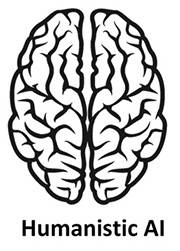About
At Media Lab we work with interdisciplinary research projects that combine advanced engineering with philosophy, art, aesthetics and other disciplines from the humanities. We aim to create disruptive media and interaction technologies, which will radically change not only the way people entertain themselves but how they live, work and think.

AI is clearly going to have an accelerating impact on our daily lives. What role can humanistic thinking play in the future of AI? The major waves on future AI are created by machine learning, automation, big data, cognitive computing, deep learning and other technologies. They are all waves of technological engineering, which we call the Engineering AI. Therefore, it is important that we also develop a strong humanistic stance with respect to AI to avoid a situation of technological intelligence overrunning humanism. This is the concept of Humanistic AI we are developing at KTH Media Lab. We need to study and redesign the ways people interact with AI systems and make sure we develop technologies that are compatible with our free liberal democratic society’s core values and study how we can build and design systems that benefit and create real value for real people. But a humanistic stance cannot only offer critical perspective. A humanistic stance can also be a source of innovation in AI. AI has much to learn from research in the humanities that could be of great use in the engineering of future AI technologies.
Humanistic AI is approaching to AI from both a (1) critical/ethical orientation and (2) an innovation orientation. These orientations are seen as two parts of a whole and as standing in dialogue with each other.
1. The critical/ethical orientation
The critical orientation is concerned with questions having to do with everything from the ethics of big data and machine learning to persuasive technologies and how AI is described in the media. Humanistic AI takes on a broad scope with respect to AI and its related technologies in order to offer a big picture and a comprehensive analysis of AI in society today, its past and its possible future. It is normative analogously to how political theory is a domain of normative inquiry. It attempts to offer direction and guidance rather than simply describing how things are. As such humanistic AI aims to be both critical and progressive.
2. The innovation orientation
Most traditionally, from the times of the inception of AI, research in artificial intelligence has been seen as self-sufficient. Much of the “orthodox” research in artificial intelligence, let us call it the first wave up until the late 1950s, was done from an engineering perspective that was, in many cases, seen as replacing research in psychology, philosophy and the rest of the humanities. This first wave was then followed with a second wave during the cognitive revolution of the 1960s and the birth of cognitive science. AI researchers then tended to think of AI research as the corner stone of the cognitive sciences, but they nevertheless derived inspiration from the rest of the cognitive sciences. During a third wave beginning in the 1980s, and a rekindled interest in neural networks, AI found increasingly more inspiration from the rest of the cognitive sciences. Much research, was e.g., neuronally inspired and continues to be so. Today we are in a situation where there is a fourth wave through which AI and established cognitive science have developed much stronger reciprocal influence than in earlier times. What we suggest with humanistic AI is a fifth wave of AI research that goes beyond such mutual reciprocal relationship between established cognitive science and AI. In humanistic AI we go through the layer of established cognitive science to research in the humanities that has not yet become part of established cognitive science. We seek to interconnect research in the humanities directly with research in AI. Such direct interconnections have not been much explored earlier, perhaps because such explorations require a true cross-disciplinary approach. Whatever the reasons may be, in humanistic AI we see great opportunities in trying to understand how AI might develop through connecting research in areas such as e.g., phenomenology, philosophy of perception and philosophy of mind with research in AI and how AI might in turn influence phenomenology, philosophy of perception and philosophy of mind. Through humanistic AI we can accelerate the development of AI and explore ideas that might never become integrated in mainstream cognitive science.
Media Lab team is in charge of several media technology and interaction design courses at KTH. Most of our team members work together on the top floor of the main building at KTH Valhallavägen, Lindstedtsvägen 5.
For more information or for arranging a visit, please contact our team leader Prof. Haibo Li, haiboli@kth.se. For more updated information about our activities, please visit our team blog.
Address
KTH Royal Institute of Technology
School of Electrical Engineering and Computer Science
Department of Media Technology and Interaction Design
Lindstedtsvägen 5, 6th floor
114 28 Stockholm
Sweden
Team
